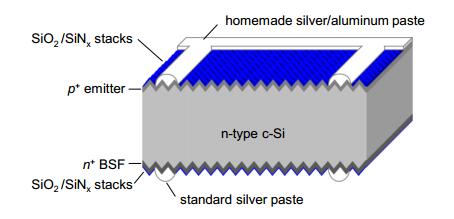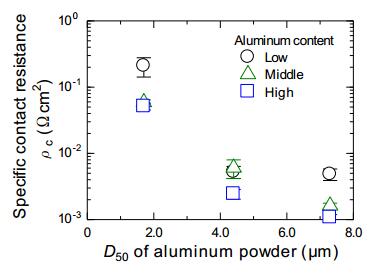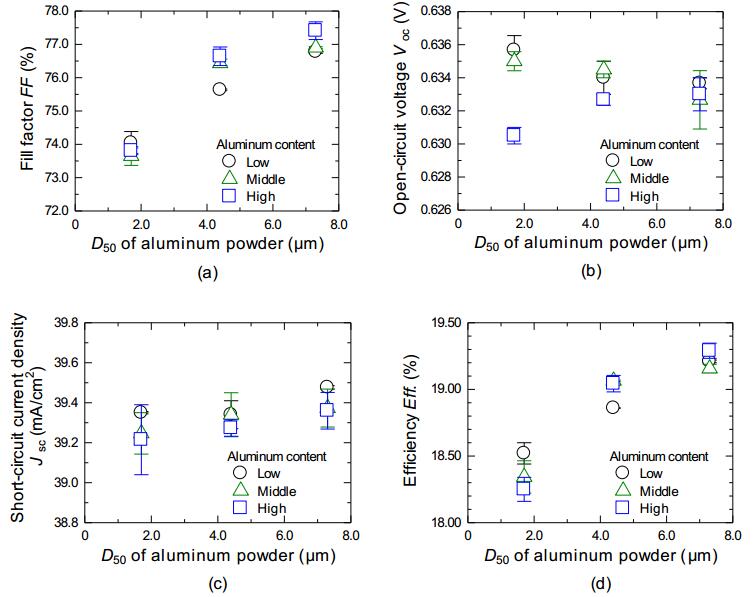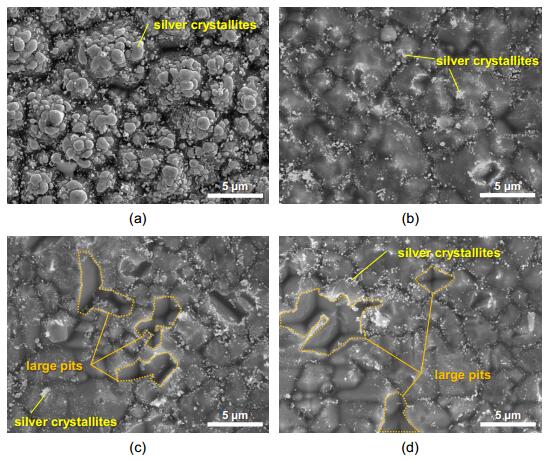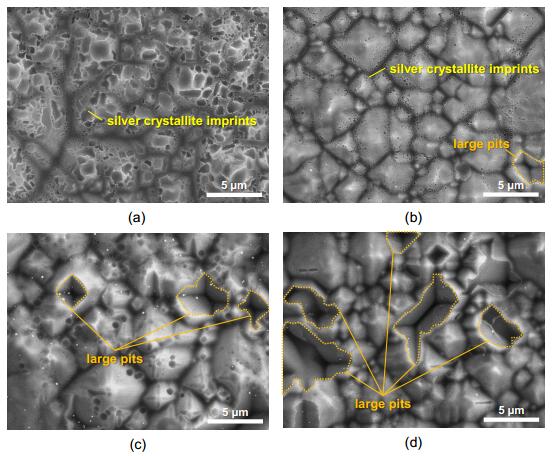1. Introduction
Conductive paste has held a prominent position on manufacturing silicon solar cells. Silver paste, which mainly consists of silver metal, glass frit, and organics, has been used for contacting the n+ emitter of conventional p-type solar cells [1], whereas aluminum-added silver paste (silver/aluminum paste) has been applied for p+ emitter of n-type solar cells [2]. The typical silver paste normally cannot contact p-type silicon with low contact resistance [2], but adding aluminum to the silver paste can effectively decrease the contact resistance [2]. The silver/aluminum contact has been applied to back side soldering pads for the conventional p-type solar cells to improve solderability of aluminum contact [3], but the aluminum in the silver/aluminum contact has been said to make electrical contact to p-type silicon [4]. Thus, the silver/aluminum paste is usually used as the contact for the p+ emitter of the n-type solar cells.
The contact resistance of the silver/aluminum paste to the p+ emitter decreases with increasing the content of the aluminum powder in the paste [2]. In addition, the silver/aluminum paste has been reported to create large and deep metallic spikes underneath the paste [5, 6], which has been considered to play a role in the decrease of the contact resistance of the paste [5], because the number of the metallic spikes increases with increasing the aluminum content in the paste [7]. Meanwhile, it has been recently demonstrated that the special aluminum-free silver paste can electrically contact to p+ emitter with low contact resistance [8], in which the metallic spikes are considered to cause shunts and recombination in the n-type solar cells. For these cases, the metallic spikes can play a big role for reducing the contact resistance, but in some cases the spikes might cause shunting of p-n junction and also severe recombination of free carriers to reduce the conversion efficiency [6]. However, our previous study has showed that the metallic spikes are not main reasons for the shunts and recombination, and that the silver/aluminum paste might have possibility to improve the quality of the contact even if the metallic spikes would be there [9]. In addition, how particle size of the aluminum powder affects the contact resistance and the electrical characteristics of the n-type solar cells has not been clear yet. For this reason, the effects of the particle size of the aluminum powder in the silver/aluminum paste on the contact resistance and the electrical characteristics must be clarified. In this study, the effects of the particle size of the aluminum powder in the silver/aluminum paste on the contact resistance and the electrical characteristics of the n-type solar cells are investigated. Our study will demonstrate that larger particle size of aluminum powder can effectively decrease the contact resistance of the silver/aluminum paste to the p+ emitter, which increases the efficiency of the n-type solar cells.
2. Materials and method
2.1. Fabrication of n-type solar cells
The n-type solar cells were prepared to measure the contact resistance and the electrical characteristics. The n-type solar cells were made using n-type Cz-silicon wafers (156 mm × 156 mm), on both sides of which the surfaces were textured with a random pyramid structure. The sheet resistance of the boron-doped p+ emitter and the phosphorus-doped n+ back surface field (BSF) were approximately 70 Ω/□ and 40 Ω/□, respectively. The p+ emitter and the n+ BSF are both passivated by a SiO2 and SiNx stack layer. The SiO2 layer was formed by thermal oxidation, and the SiNx layer was deposited with a plasma-enhanced chemical vapor deposition (PECVD). For the measurement of the contact resistance, homemade silver/aluminum pastes were screen-printed on the p+ emitter side in the line pattern of the transfer length method (TLM) geometry shown in Figure 1 by using a screen printer, and dried at 120 ℃ for 10 minutes. The line length of the TLM pattern is 2 cm, and the distance of the adjacent lines are varied as 100, 300, 500, 800, 1200, 1500, 1800, and 2000 µm. After screen-printing and drying, the screen-printed pastes were fired with an infrared belt furnace at a set peak firing temperature of 910 ℃. Meanwhile, for the measurement of the electrical characteristics, the silver/aluminum pastes and commercially available silver paste were screen-printed on the p+ emitter side and on the n+ BSF side with a standard H-pattern consisted of 3 busbars and 80 fingers, respectively, as shown in Figure 2. After screen-printing and drying, the screen-printed pastes were co-fired with the same furnace. The illuminated I–V curves were measured with an I–V tester and a solar simulator under an air mass 1.5 G spectrum with an intensity of 100 mW/cm2 at 25 ℃.
2.2. Constituents in silver/aluminum paste
The silver/aluminum pastes used in the study consists of silver powder, glass frit, organics, and aluminum powder. The glass frit mainly consists of silicon oxide, lead oxide, boron oxide, and zinc oxide. In this study, the particle size (particle diameter) and the content of the aluminum powder in the silver/aluminum pastes were varied, whereas the other constituents in the paste, i.e., the silver powder, the glass frit, and the organics, remained constant. For the particle size, three types of aluminum powder with different particle-size distribution were prepared, whose particle diameters: D10, D50, and D90 are shown in Table 1. D10, D50, and D90 represent particle diameters at which 10, 50, and 90 volume percent of particles in a powder is comprised of less than these diameters; for example, in the case of the aluminum powder AP1S, 10 volume percent of the aluminum particles in the powder has the diameter less than 0.9 µm. In addition, SEM images of the three aluminum powders are shown in Figure 3. The aluminum content was defined as weight percent ratio of the aluminum powder to the silver in the paste, which were varied as "low", "middle", and "high" content in the range of below a few weigh percent.
Table 1. Particle size distribution of the aluminum powders used in this study.
| Aluminum powder |
D10 |
D50 |
D90 |
| AP1S |
0.9 µm |
1.7 µm |
3.1 µm |
| AP2S |
2.1 µm |
4.4 µm |
8.7 µm |
| AP3S |
3.0 µm |
7.3 µm |
13.9 µm |
2.3. Observation of interface morphology
The interface morphology between the paste and the p+ emitter was observed with a scanning electron microscope (SEM) after removal of the fired paste. For the observation, the bulk contact only was removed by a mixture of HNO3 and HCl. The glass layer under the bulk contact was etched off by a diluted HF, and then metal precipitates under the glass layer were also etched off by the same mixed acid used in the removal of the bulk contact.
3. Results
3.1. Effects of aluminum powder on contact resistance
Figure 4 shows the dependence of the specific contact resistance ρc on the D50 of the aluminum powder in the silver/aluminum paste. It should be noted that the ρc of the silver paste with no aluminum was around 100 mΩcm2, which was not plotted on Figure 4. For all the aluminum content in the paste, the ρc monotonically decreases with increasing the D50 of the aluminum powder. In addition, a similar tendency can be observed in the dependence of the aluminum content in the paste on the ρc; specifically, the ρc decreases with increasing the aluminum content in the paste. The results clearly show that the larger particle size of the aluminum powder can effectively reduce the contact resistance of the silver/aluminum paste to the p+ emitter. For instance, the ρc for the high content of the aluminum powder with the D50: 1.7 μm is approximately 50 mΩcm2, whereas that for the same content of the powder with the D50: 7.3 μm is approximately 1 mΩcm2.
3.2. Effects of aluminum powder on electrical characteristics of n-type solar cells
Subsequently, the effects of the particle size of the aluminum powder on the electrical characteristics of the n-type solar cells are investigated. Figure 5 shows dependence of the cell parameters, FF, Voc, Jsc, Eff., on the D50 of the aluminum powder in the paste. The FF of the n-type solar cells increases with increasing the D50 of the aluminum powder and with increasing the aluminum content in the paste. By contrast, dependence of the Voc on the D50 of the aluminum powder is different depending on the aluminum content in the paste. For the low and middle aluminum content, the Voc decreases with increasing the D50 of the aluminum powder. On the other hand, the Voc of the high aluminum content increases with increasing the D50, but the Voc gets to the same value, i.e., around 633 mV, regardless of the aluminum content. In addition, the dependence of the Voc on the aluminum content in the paste becomes weaker as increasing the D50. Meanwhile, the Jsc of the solar cells slightly increases with increasing the D50 of the aluminum powder. Hence, the efficiency of the n-type solar cells increases with increasing the D50 of the aluminum powder, which correlates well with the dependence of the FF on the D50; then, the n-type solar cells with the silver/aluminum paste using the aluminum powder of D50: 7.3 µm can effectively increase the efficiency of the cells.
3.3. Interface morphology underneath silver/aluminum paste
Figures 6 and 7 show the interface morphology underneath the silver paste with no aluminum and the silver/aluminum paste with the high content of aluminum powder. Top-views of the interface morphology after the removal of the bulk contact and the underlying glass layer are shown in Figure 6. Metal precipitates appear on the silicon surface after the removal. Actually, many precipitates, which are silver crystallites precipitated from the silver paste with no aluminum during the firing, are observed underneath the paste, as shown in Figure 6a. By contrast, the silver crystallites become smaller by adding aluminum to the paste, and in addition large pits can be observed underneath all silver/aluminum pastes.
Figure 7 shows top-views of the interface morphology after the removal of the metal precipitates by the mixed acid. The morphology of the wafer surface deformed by the pastes can be observed by the removal of the metal precipitates. Actually, the morphology deformed by the silver paste and the silver/aluminum pastes can be clearly seen in Figure 7. Many pits which are imprints of the silver crystallites can be observed underneath the silver paste with no aluminum, but the silver crystallite imprints become smaller by adding the aluminum to the paste. The imprints underneath the silver/aluminum paste with the aluminum powder of D50: 1.7 µm are obviously smaller compared with that underneath the silver paste. On the other hand, the silver crystallite imprints become fewer with increasing the D50 of the aluminum powder; instead, large pits whose sizes are comparable with the texture can be observed underneath the silver/aluminum paste. In addition, the large pits increase with increasing the D50 of the aluminum powder. It has been reported that the large pits are formed by metallic spikes due to aluminum addition to silver paste. Thus, the large pits observed in this study are obviously caused by the aluminum addition.
4. Discussion
In this study, the effects of the particle size of the aluminum powder in the silver/aluminum paste on the contact resistance and the electrical characteristics of the n-type solar cells are investigated. The contact resistance of the silver/aluminum paste decreases with increasing the aluminum content in the silver/aluminum paste, which is consistent with the results of previous researchers [2], but it was also demonstrated that the contact resistance decreases with increasing the particle size of the aluminum powder. Since the surface of the aluminum particle is oxidized [10], the metal aluminum in the particle needs to burst through the external oxide layer during the firing to affect the contact formation between the silver/aluminum paste and the p+ emitter [7]. In addition, the volume ratio of the metal aluminum to the full volume of the aluminum particle increases with increasing the aluminum particle size. Hence, the larger the aluminum particle size becomes, the easier the metal aluminum in the aluminum particle can burst through the external oxide layer; therefore, the contact resistance decreases with increasing the particle size of the aluminum powder. In addition, the size of the large pits increases with increasing the particle size of the aluminum powder, which correlates with the dependence of the contact resistance on the particle size of the aluminum powder; therefore, the large metallic spikes must relate to the contact resistance decrease. In addition, the interface morphology indicates that the silver crystallites do not have the predominant effect on the contact resistance decrease, because the contact resistance decreases with increasing the aluminum content though the number of the crystallites decreases.
The dependence of the contact resistance on the aluminum powder in the silver/aluminum paste strongly correlates with the dependence of the FF on the aluminum powder; that is, the FF increases with increasing the particle size of the aluminum powder and with increasing the aluminum content in the paste. Thus, the FF increase can be explained by the contact resistance decrease due to the particle size of the aluminum powder and the aluminum content in the paste. In contrast, the dependence of the Voc on the particle size of the aluminum powder is different depending on the aluminum content in the silver/aluminum paste. For the low and middle aluminum content, the Voc decreases with the particle size increase of the aluminum powder, whereas for the high aluminum content in the paste the Voc slightly increases. Then, the larger particle size of the aluminum powder in the silver/aluminum paste can effectively decrease the contact resistance, which can increase the FF, resulting in increasing the efficiency of the n-type solar cells.
5. Conclusions
In this study, the effects of the particle size of the aluminum powder in the silver/aluminum paste on the contact resistance and the electrical characteristics of the n-type solar cells are investigated. Our study demonstrates that the contact resistance decreases not only with increasing the aluminum content in the paste, but also with increasing the particle size of the aluminum powder.
The contact resistance decrease by the aluminum addition can relate to the large metallic spikes underneath the silver/aluminum paste. The dependence of the FF of the solar cells on the particle size of the aluminum powder correlates well with that of the contact resistance on the particle size. Thus, the aluminum powder with the large particle size can effectively reduce the contact resistance of the paste. By contrast, the Voc of the silver/aluminum paste with such a larger size of the aluminum powder is lower than that with the smaller size of the aluminum powder. Then, the n-type solar cells with the silver/aluminum paste containing larger particle size of the aluminum powder show the higher efficiency due to the higher FF. The cell efficiency, however, should further increase when the higher FF realized by the high aluminum content with the D50: 7.3 µm and the higher Voc realized by the low aluminum content with the D50: 1.7 µm are simultaneously achieved.
Conflict of interest
The authors declare no conflicts of interest associated with the study.









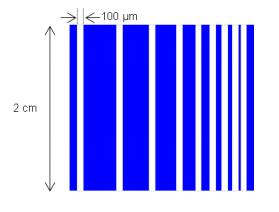
 DownLoad:
DownLoad: 